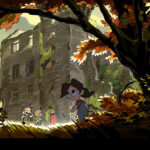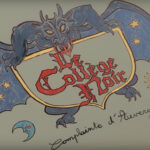Ours is a Celtic country, full of phantoms, elves, and fairies.
– Agnes Mary Frances Duclaux
Comic book artist, writer, and director Ulysse Malassagne is on a mission to bring Auvergne’s oldest legends to new audiences. In 2023, he unveiled Le Collège Noir — an animated series that takes inspiration from the folklore of Cantal, where Malassagne was born and raised. Le Collège Noir follows the adventures of a group of students as they unravel the mysteries behind a sorcerous secret that threatens to tear their world apart.
The series, which was created by Malassagne’s company Studio La Cachette and co-produced by famed Japanese studio Toei Animation, is a testament to the enduring impact of Cantal’s spell-binding folkloric traditions. I caught up with Malassagne to learn more about how his experiences growing up in Cantal influenced his artistic pursuits.
A. D. Manns: When were you first introduced to the folklore of Cantal? Did you grow up in a community that was very passionate about storytelling?
Ulysse Malassagne: My father’s family has been in Cantal for as far back as I know. Both my parents were artists. My father was a comedian and my mother a painter and singer, so I had a family naturally drawn to arts and stories, including local stories from the area. My father did a lot of readings and cultural events centred on Cantal traditions and folklore.
AM: There are many stories about mysterious entities in Auvergnat folklore; the “drac” for example, is an elf-like creature that had a notorious reputation throughout the mountains, especially in Cantal. When you were growing up, did you ever hear local tales about magic and otherworldly beings?
UM: I did from my parents and it was mentioned in some local books and cultural events. But most of the tales and legends I heard about in Cantal were centred around the devil. It feels like, besides the drac that is pretty much present all around France under different names (like korrigans in Brittany), I couldn’t find any specific creatures that are well-known for being exclusively associated with Cantal folklore.
AM: Did you or anyone you know ever witness anything in the countryside that you couldn’t explain?
UM: Not really, but I like playing along and imagining that particular noises and lights seen through the forest could be some creatures or ghosts.
AM: What for you is most inspiring about the landscapes of Cantal?
UM: There is nothing like it anywhere else in France. It’s the biggest volcano formation in Europe, and it’s rocks and valleys can tell a lot of history. It can feel like a green paradise in spring and like a cold dark mysterious place in winter. Being really hard to visit from the big cities, it stayed relatively well-preserved from tourism.

AM: You’ve cited Maupassant and Lovecraft as two of your favourite authors. Which of their writings were the most influential on your imagination and overall creative process?
UM: All of Lovecraft’s and Maupassant’s novels were pretty inspiring for being (most of them) written in a subjective way, as if the story was lived by the author himself and the novel was actually a testimony. I like this approach of blurring the line between reality and fiction, and these authors were pretty good at it. Also the themes of horror and haunting creatures always attracted me.
AM: What other projects are you currently working on?
UM: I’m working on the season 2 of Collège Noir, my horror/adventure animated series. I started the writing and hopefully it will go into production by the end of the year.

For more on Ulysse Malassagne’s work, check out Studio La Cachette’s homepage.







